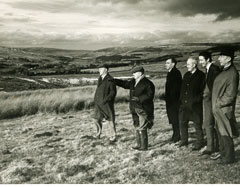History
Club History
When and where did it all start?
The Club Was Founded In 1905
The first course was at Black House Farm. It officially opened Easter Monday 1906 although there is evidence that a club existed some time before this date.

The First Course
The first course was at Black House Farm. It officially opened Easter Monday 1906 although there is evidence that a club existed quite some time before this date.
The first President was Mr R.H.Horrocks of Salkeld Hall, a skilful golfer, 6 handicap and an accomplished cricketer who played many times for Cumberland. He was a founder member of Penrith GC in 1890 and Captain in 1905. He went on to be elected Sheriff of Cumberland in 1911. He resigned as President of Alston GC in 1913 due to serious illness although his wife continued to play and serve as Vice-President until 1923.
In 1914, following a disagreement over rent with landowner Mr Walton Dickinson, the Course was re-located at Bayle Hill. The Course was 9 holes with a total length of 1670 yds (2 par 3’s, 7 par 4’s).

The New Course
The new Course was opened in 1914 by Mr Fleming and Mr Lamonby of Penrith in an exhibition match.
Unfortunately, with the outbreak of war, the Club was put into abeyance. They lost the tenancy of this new Course and in 1919, the Club decided to move back to the old course. Debts continued to mount and in 1923 the Club was wound up.
There are no records in existence for the period between 1923 – 1935 but anecdotal evidence from older Members recalled that the Course at Randalholme was opened in 1924, when a match was played between Capt. A.C.N. Dixey M.P. and Mr Frank Hodges M.P. Further evidence is provided from the inscription on the Royse Cup provided by Rev. W.H.Harvey Royse and first played for in 1925/6 season.
The President, at this time, was Mr W.J. Horrocks continuing the family connection with Alston Golf Club. A fine golfer and playing out of Penrith G.C., he was Cumbria Union Captain 1926 – 1945 and Cumberland Union Matchplay champion in 1923,1926 and 1928. He also went on to be elected Sheriff of Cumberland in 1937. The period between 1924 and the 1939-45 war was the most successful in the Clubs history. The Course was extended to 12 holes, enjoyed a thriving membership, and attracted many visitors. Annual matches were played with Allendale, Brampton and Tynedale, without much success however by the Alston Players! By 1942, however, due to the war, competitions were suspended for the duration. Little effort was put into maintaining the course.
Royse Cup Final 1925/6 Randalholme.
The Club was revitalised in 1946 under the Presidency of Mr T.W.Maughan. Much work was required to bring the Course back into play. This took another 2 years and so it was in 1948 that the Course was officially re-opened.
1953 marked a turning point in the success of the Club. Mr W.G.Ball was elected President and was instrumental in involving local industry in the affairs of the Club.
Throughout the tenancy at Randalholme the Club had the friendliest relations with their landlord, Mr H. Raine and his predecessors, who had co-operated whenever possible to help the Club.

The Hermitage 1969
The President, at this time, was Mr W.J.H. Horrocks continuing the family connection with Alston Golf Club. He served from 1924 until 1942. A fine golfer and playing out of Penrith G.C., he was Cumbria Union Captain 1926 – 1945 and Cumberland Union Matchplay champion in 1923,1926 and 1928. He also went on to be elected Sheriff of Cumberland in 1937.
The period between 1924 and the 1939-45 war was the most successful in the Clubs history.
The Course was extended to 12 holes, enjoyed a thriving membership, and attracted many visitors. Annual matches were played with Allendale, Brampton and Tynedale, without much success however by the Alston Players!
By 1942, however, due to the war, competitions were suspended for the duration. Little effort was put into maintaining the course.
However, with the changing pattern of farming, it became increasingly difficult to reconcile the needs of the Golf Course with those of a farm. This led to a considerable reduction in the number of visitors and loss of interest among the Members.
It was resolved in 1966 to look for an alternative site and in December 1968 it was learnt that Hermitage Farm was for sale, which comprised 132 acres of land and two farmhouses.
With grants from the Dept of Education and Science, the help of two local companies, Precision Products Ltd and Alston Foundry Ltd, who gave interest free loans, the Playing Fields Assoc., who gave grant aid and the members of the Club who made donations and interest free loans, Hermitage Farm was purchased by the Club in 1969.